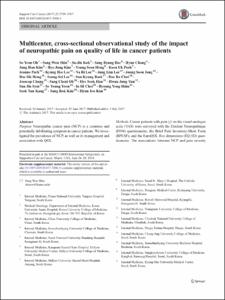KUMEL Repository
1. Journal Papers (연구논문)
1. School of Medicine (의과대학)
Dept. of Internal Medicine (내과학)
Multicenter, cross-sectional observational study of the impact of neuropathic pain on quality of life in cancer patients
- Keimyung Author(s)
- Park, Keon Uk
- Department
- Dept. of Internal Medicine (내과학)
- Journal Title
- Supportive Care in Cancer
- Issued Date
- 2017
- Volume
- 25
- Issue
- 12
- Keyword
- Pain management; Neuropathic pain; Quality of life; Neoplasm
- Abstract
- PURPOSE:
Neuropathic cancer pain (NCP) is a common and potentially debilitating symptom in cancer patients. We investigated the prevalence of NCP, as well as its management and association with QOL.
METHODS:
Cancer patients with pain ≥1 on the visual analogue scale (VAS) were surveyed with the Douleur Neuropathique (DN4) questionnaire, the Brief Pain Inventory-Short Form (BPI-SF), and the EuroQOL five dimensions (EQ-5D) questionnaire. The associations between NCP and pain severity or NCP and QOL, while controlling for variables relevant to QOL, were then analyzed.
RESULTS:
A total of 2003 patients were enrolled in this survey; the prevalence of NCP was 36.0% (n = 722, 95% CI, 32.5-39.5). We found that NCP in cancer patients was closely correlated to a higher pain severity (BPI-SF; 4.96 ± 1.94 versus 4.24 ± 2.02, p < 0.001), and in patients with NCP, pain more severely interfered with daily living, as compared to those without NCP (BPI-SF; 4.86 ± 2.71 versus 4.41 ± 2.87, p < 0.001). Patients with NCP also had worse QOL than those without NCP, as measured by EQ-5D index score (0.47 ± 0.30 vs. 0.51 ± 0.30, p = 0.005), and this was confirmed using multivariate analysis (p < 0.001), even after controlling for other variables such as age, sex, disease stage, cancer duration, radiotherapy, chemotherapy, and comorbidities. Importantly, adjuvant analgesics were used in less than half of patients with NCP (n = 358, 46.4%).
CONCLUSIONS:
We found that NCP in cancer patients was significantly associated with a worsened QOL, and current management is inadequate. Therefore, future research aimed at developing improved strategies for management of NCP is required.
- Keimyung Author(s)(Kor)
- 박건욱
- Publisher
- School of Medicine (의과대학)
- Citation
- So Yeon Oh et al. (2017). Multicenter, cross-sectional observational study of the impact of neuropathic pain on quality of life in cancer patients. Supportive Care in Cancer, 25(12), 3759–3767. doi: 10.1007/s00520-017-3806-5
- Type
- Article
- ISSN
- 0941-4355
- Appears in Collections:
- 1. School of Medicine (의과대학) > Dept. of Internal Medicine (내과학)
- 파일 목록
-
-
Download
 oak-2018-0738.pdf
기타 데이터 / 453.29 kB / Adobe PDF
oak-2018-0738.pdf
기타 데이터 / 453.29 kB / Adobe PDF
-
Items in Repository are protected by copyright, with all rights reserved, unless otherwise indicated.